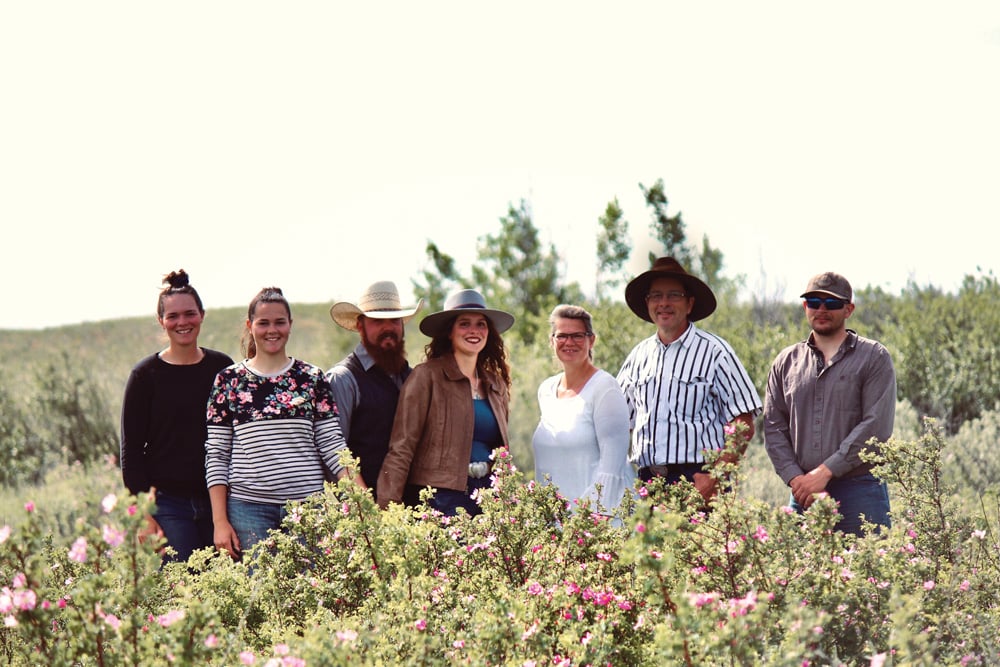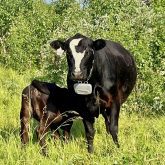When the Longhorn first arrived in southern Saskatchewan’s Great Sandhills, this resilient breed was considered the ideal cow for this semi-arid landscape.
In the late 1880s, Sir John Lister Kaye brought 7,000 Longhorn females to this area from Wyoming, the majority of which stocked his newly established ranch at Crane Lake. He ran imported purebred Angus and Galloway bulls with his cows, producing crossbred calves that fit the dry conditions and rougher native forage of the Sandhills.
This understanding of the value of Longhorn genetics is present today in another noteworthy area ranch. The McNary family of TLC Ranch at Tompkins, Sask., has used the breed to help get the most out of this landscape, fitting well into a larger program that has allowed them to expand their herd and improve quality without increasing labour input.
Read Also

Body condition, nutrition and vaccination for brood cows
One of the remarkable events of the past century related to ranching has been the genetic evolution of brood cows….
“The Longhorn cow can be an important building block in the nation’s cow herd, but she has to be the right kind of cow,” says Warren McNary, who established TLC Ranch with his wife, Lenamarie, in 1993. Today their four adult children — Grace, Bess, Tyler and Sarah — all continue to play a role in the running of the ranch, either full- or part-time.
McNary became interested in using Longhorn genetics after seeing how other producers had used this breed, including a producer using Red Angus bulls on Longhorn females.
“I really liked the look of his calves and what he was doing,” he says. “When we started ranching and wanted to look for a cross that would work here, I kept thinking of those cattle and decided we would try that.”
Choosing the right genetics to allow cattle to thrive in the Great Sandhills was key to their success. Covering approximately 22,000 acres, their ranch receives about seven inches of annual rainfall on average. Compared to other parts of the province, McNary explains, winters are generally short and mild with little snowfall, whereas summers are usually dry and hot.
Around 60 per cent of their landbase is native prairie, consisting of sandhills and open, rolling clay hills, while the other 40 per cent is primarily seeded pasture. While dry conditions early in spring make it difficult for seeded hay to do well, they tend to have better yields with greenfeed.
“As the ranch grew, we were looking for a smaller, more feed-efficient cow suited to our dryland conditions, one that would take very little care and yet still produced a good, marketable calf that performed well in the feedlot,” says McNary.
In comparison to the scale of Australian beef operations, for example, what they were running at the time wasn’t enough to make a living. “On average, those large stations down there run about 3,000 animals for every person on the station, and when we started ranching 27 years ago, the Canadian average herd size was something like 50 animals per person,” he says. “We have to be able to run a lot more animals per person to be competitive.”

In addition to better feed efficiency and lower maintenance, they wanted cattle that could thrive on the rougher forage of their native pastures and graze into the winter. “We had set a target at 1,000 cows for one family, and we were able to achieve that with these cattle and also the type of country that we live in, the time of year that we breed, our feeding program, winter grazing (and) our herd health program,” he says. “Mixing the Longhorn into our breeding program was one of the components of that bigger picture.”
Thanks to an early spring, they usually turn yearlings out to grass carried over from the previous year around March 20, a month before calving. In early April, they’re able to turn cows out to tame pastures, but if there’s a snowstorm they can return to the sandhills for shelter.
They start calving in mid-April on grass, reducing both labour inputs and necessary infrastructure. “We let them calve on their own, but we’re successful doing it because at that time of year, you’re not worried about frozen ears and calves that are getting chilled,” he says.
At this point, the cows are moved to seeded pastures until mid to late summer when it dries out, then onto native prairie.
McNary explains that before the grass dries out in summer, there’s a period of growth in June that allows for the females to be in top condition to cycle, which is key to their high conception rates. Bulls are turned out in mid-July for a very short breeding season, usually only 45 days or two cycles. In 2020, their half-blood heifers were bred for only 25 days, which resulted in an 87 per cent conception rate.
“By September the cows are in the open, rolling hills of native grass where they will remain until after weaning,” says McNary. “Weaning takes place in late October, then the cows go back out on native pasture in the open country for a month or so to pick up some condition before winter.”
In late December, they generally move the cows to the sandhills, where the brush provides wind shelter. With less snow to contend with on average, they graze throughout the winter along with supplementary feed each day. This also cuts down on infrastructure costs and the labour of cleaning and bedding corrals.
Repositioning Longhorn females in the market
Moving from a commercial British-based herd to a primarily Longhorn-cross herd took about 10 years. Though they had purchased some Longhorns in the late 1990s, it wasn’t until the post-BSE years that they started buying larger numbers of females. At first, they bred them to Black Angus bulls and didn’t retain any replacements.
As time went on, they began retaining heifers for breeding and bulls for their own use before they began marketing bulls to commercial producers. “We wanted solid-coloured cattle. We wanted large-framed, beefy cattle and we didn’t want horns,” says McNary.
“So when we found it hard to find those kind of females, then we started buying Longhorn bulls and raising some Longhorn bulls and raising our own Longhorn replacement females.”

Before the fall of 2020, the McNarys bred approximately 1,000 head every year, which included up to 300 heifers. They generally sold up to 250 bred females each fall, then calved about 700 head in the spring. They also background most of their steers and cull heifers on grass, then finish them in a custom feedlot.
The foundation of their breeding program is referred to as the “Select” herd, consisting of about 130 purebred Longhorn females, bred each year to purebred bulls. “We typically breed around 80 to 100 pure Longhorn heifers as well, so usually have about 200 straight Longhorn calves hit the ground each spring,” he says.
“The best of these heifers, usually about 25 or 30, stay in this ‘Select’ herd, and the rest go to the crossbreeding herd.” They also retain around 25 purebred bulls as herd sires or to sell by private treaty.
Their main herd of females used for crossbreeding are bred to Black Angus bulls, purchased from Johnson Livestock at Peebles, Sask., and selected for maternal traits and moderate-sized frames.
“The Longhorn in them contributes increased fertility, longevity, docility, mothering instincts, calving ease, feed efficiency and adds marbling to the carcass. We get excellent udders and feet that makes these cows very desirable range cows.”
The top half-blood bulls are sold as yearlings and two-year-olds. “We have tapped into a fast-growing market for these calving-ease bulls among commercial ranchers who are calving large numbers of heifers and who don’t want to be up every two hours every night to check them,” says McNary. “We have had customers buying as many as 25 of these crossbred bulls in one purchase.”
The best half-blood heifers are retained as range cows, bred to half-blood bulls for their first calf and to Angus bulls the second year. “We have had excellent results with both Angus and polled black Simmental bulls on these cows when we breed them as two-year-olds and older,” he says, adding that they’ve also been pleased with Shorthorn and Limousin genetics and are now using Charolais bulls as a new three-way cross.
Their crossbred calves have done very well on feed, with admirable feed conversion rates, high yields and top carcass grades. In 2019, they sent 20 Longhorn-Angus steers to Olds College for a finishing trial using GrowSafe feed conversion technology.
“They compared our steers to their own college-owned steers, and they gained exactly the same amount, 3.3 lbs. per day on the finishing ration, but our cattle took 17 per cent less feed per day,” says McNary.
The continued development of their operation comes through always making improvements and setting new goals. Currently, they plan to try a new breeding program with a small number of animals, in which they’ll produce a five-eighths Angus and three-eighths Longhorn cross instead of a half-blood. The objective is to ensure genetics are more predictable and result in fewer throwbacks favouring one breed.
Another goal is to find a niche market for their beef. They sell a number of finished purebred Longhorns for beef through direct marketing each year, with many repeat customers. In 2020, thanks in part to the rising demand for locally produced food, they sold around 60 animals for beef directly to consumers.
“Straight Longhorn meat is as nice a meat as you can get,” says McNary. “These cattle have finer-grained meat, which marbles very well and is inherently tenderer. Many customers are surprised at how tender and tasty they are. The smaller frames mean a more desirable size for the freezer and smaller cuts, which suit their needs better.”
The success that TLC Ranch has had in focusing on more efficient cattle with lower inputs, as well as the interest from their commercial customers, proves to McNary that there’s an opportunity in tailoring more production systems in this manner. Although some may see the Longhorn’s influence as only a chapter in the history books, he believes the breed can reprise its role and bring with it the performance traits that first made it attractive to ranchers in the Great Sandhills, traits still highly sought after in today’s markets.
“We feel it is time to reposition the Longhorn cow in the beef market, not as a recreational or decorative novelty item, but as an honest-working female who can pull her own weight, earn her own keep and pay the bills on a commercial ranching operation.”

















